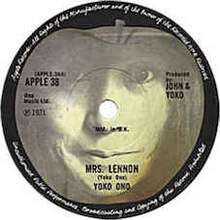Mrs. Lennon
"Mrs. Lennon" is Yoko Ono's first single from her second studio album Fly (1971). It includes the B-side "Midsummer New York". The song was also featured in the film Imagine (not to be confused with the documentary about John Lennon's life).
| "Mrs. Lennon" | ||||
|---|---|---|---|---|
 | ||||
| Single by Yoko Ono | ||||
| from the album Fly | ||||
| B-side | "Midsummer New York" | |||
| Released | 29 September 1971 (US) 29 October 1971 (UK) | |||
| Genre | Pop | |||
| Length | 4:12 | |||
| Label | Apple Records | |||
| Songwriter(s) | Yoko Ono | |||
| Producer(s) | Yoko Ono, John Lennon | |||
| Yoko Ono singles chronology | ||||
| ||||
Slant Magazine critic Zachary Hoskins described "Mrs. Lennon" as a "haunting, piano-led ballad."[1] Ono biographers Nell Beram & Carolyn Boriss-Krimsky described the song's theme as the way the public defined Ono solely as ex-Beatle John Lennon's wife and did not recognize her as an artist in her own right.[2] Beram & Boriss-Krimsky feel that the lack of promotion her records including Fly received was a reflection of this theme, since her record company did not believe that the public would be interested in Ono's solo work.[2] Ben Urish and Ken Bielen described the song's theme similarly, stating that it is an "ironic ballad" that it sounds like a love song, but the lyrics describe Ono's anxiety about losing her identity.[3] Allmusic critic Ned Raggett called the song "reflective," stating that it provides "as wry but heartfelt a portrait of her position in the public eye as any."[4] Pitchfork critic Mark Masters calls it an attempt by Ono to write a more conventional song than she has in the past and describes it as "glammy balladry."[5] Masters describes her singing as "somber" and notes that she is accompanied by Lennon's "slow piano chords."[5] Urish & Bielen praise Lennon's piano work, describing it as "evocative faux classical piano playing."[3] Spill Magazine critic Aaron Badgley stated that "Mrs. Lennon" is "proof that Ono can write, and produce standard pop ballads, but even then, she throws in her own curves which makes the song that more interesting and enjoyable."[6] Lennon biographer Geoffrey Giuliano described the song as "haunting."[7] Lennon described it as more of a "straight" track than her previous work, stating that it shows off "her more conservative side."[8] Alex Chilton used the song's sad chord progression for part of his song "Holocaust."[1][4][9]
Video
A music video was made for this song which was premiered on "The Dick Cavett Show" on 11 September 1971 when John Lennon and Yoko Ono were guests on the programme.[10][11] (The video is introduced at approximately the 39:24 mark). Film of "Mrs. Lennon" depicting the couple walking around their Ascot mansion was included in the 1972 television film Imagine.[12][13][14]
Personnel
- Yoko Ono – vocals
- John Lennon – piano, organ
- Klaus Voorman – bass, bells
References
- Hoskins, Zachary (26 July 2017). "Yoko Ono's Fly, Approximately Infinite Universe, and Feeling the Space, Reissued and Reevaluated". Slant Magazine. Retrieved 22 November 2017.
- Beram, Neil & Boriss-Krimsky, Carolyn (2012). Yoko Ono: Collector of Skies. Abrams. ISBN 9781613125137.CS1 maint: multiple names: authors list (link)
- Urish, B. & Bielen, K. (2007). The Words and Music of John Lennon. Praeger. p. 35. ISBN 978-0-275-99180-7.
- Raggett, N. "Fly". Allmusic. Retrieved 11 January 2013.
- Masters, Mark. "Yoko Ono: Fly". Pitchfork. Retrieved 22 November 2017.
- Badgley, Aaron. "Yoko Ono: Fly". Spill Magazine. Retrieved 22 November 2017.
- Giuliano, Geoffrey (2001). Lennon in America: 1971-1980, Based in Part on the Lost Lennon Diaries. Rowman & Littlefield. ISBN 9780815411574.
- Prince, Rosa (21 October 2014). "John Lennon letter introducing New York radio host to Yoko Ono's 'far out' music is up for auction". The Telegraph. Retrieved 22 November 2017.
- George-Warren, Holly (2014). A Man Called Destruction: The Life and Music of Alex Chilton, From Box Tops to Big Star to Backdoor Man. Penguin. ISBN 9780698151420.
- Robinson, Charlotte (2 December 2005). "The Dick Cavett Show: John & Yoko Collection". PopMatters. Retrieved 22 November 2017.
- Cavett, Dick (11 September 1971). "Dick Cavett Show". YouTube. YouTube. Retrieved 10 February 2017.
- Seideman, Tony (26 October 1985). "Big Music News at Mipcom Market". Billboard Magazine. p. 28. Retrieved 22 November 2017.
- Doggett, Peter (2009). The Art And Music Of John Lennon. Omnibus Press. ISBN 9780857121264.
- Badman. Keith (2009). The Beatles Diary Volume 2: After The Break-Up 1970-2001. Omnibus Press. ISBN 9780857120014.